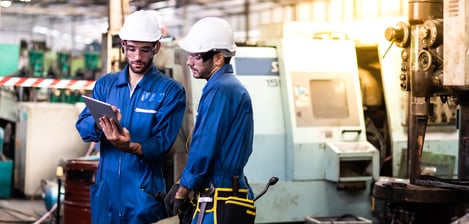Balancing people and technology to optimise plant operations.
In its relentless march toward end-to-end automation, technology has continually up-ended the boundaries between man and machine in industrial enterprises. With recent advances in artificial intelligence supported by endless computing resources in the cloud, we must now ask ourselves, “how much longer will we need people directly involved in manufacturing?”
The fact is, we will always have people involved in process manufacturing plants. So perhaps the better approach is to look for ways to create an environment where we are able to balance the best attributes of people and technology to assure optimisation of communication, safety and production. This article will explore new roles within an organisation and how technology, created to support critical human factors, will help people and machines collaborate to provide the breakthrough advances in productivity that society needs in the decades to come.
The Machine/Human Connection
 As long ago as the 1950s, scientists were exploring the relationships between people and machines with the launch of the field of inquiry known as function allocation research. While technology has certainly evolved over the last 70 years, the basic findings of a scientist by the name of Paul Fitts, the creator of the Fitts list, remain largely valid. Function allocation has become a central component of systems engineering and its main aim is to provide a rational means of determining which system-level functions should be carried out by humans and which by machines. Although other methods have been developed, Fitts list still remains the most oft-cited research in the more complex manufacturing world of today.
As long ago as the 1950s, scientists were exploring the relationships between people and machines with the launch of the field of inquiry known as function allocation research. While technology has certainly evolved over the last 70 years, the basic findings of a scientist by the name of Paul Fitts, the creator of the Fitts list, remain largely valid. Function allocation has become a central component of systems engineering and its main aim is to provide a rational means of determining which system-level functions should be carried out by humans and which by machines. Although other methods have been developed, Fitts list still remains the most oft-cited research in the more complex manufacturing world of today.
In his research, Fitts outlined six areas where people prevail. These areas include detection, perception, judgement, induction, improvisation and long-term memory. Conversely, according to Fitts, machines excel at speed, power, computation, replication, simultaneous operations, and short-term memory.
So, in looking toward technology investments, the focus should not be simply on replacing people with machines but rather how, using the positive attributes of both people and machines, there can be productive and symbiotic relationships.
Highlighting the Human Factor
 You may think that the massive reduction in the price of computer memory over time would mean that the original Fitts list from the 1950s no longer applies. However, many organisations have simply invested in data storage without considering how it will be accessed, understood and used in practice. Storing data only makes sense if it is relevant and actionable. This requires data that can be processed and appropriately visualised for people. It is very easy to overwhelm people with data and make things too complicated. Understanding human factors is essential to avoid these problems.
You may think that the massive reduction in the price of computer memory over time would mean that the original Fitts list from the 1950s no longer applies. However, many organisations have simply invested in data storage without considering how it will be accessed, understood and used in practice. Storing data only makes sense if it is relevant and actionable. This requires data that can be processed and appropriately visualised for people. It is very easy to overwhelm people with data and make things too complicated. Understanding human factors is essential to avoid these problems.
Human memory works differently than machine memory. While machines are very good at capturing and storing data, humans are able to remember perceptions, images and feelings. Thus, only people can draw on human attributes to create a better understanding from things that have been experienced or memorised from past experiences.
Reliability is another example. Machines are reliable only for certain defined situations for which they’ve been programmed, i.e. repeating the same set of actions on a production line. People, however, through their powers of perception, improvisation, detection, among other attributes, are reliable within and outside of the defined operational domain because they can continually adapt. Thus, the reliability of people and machines cannot be measured in the same way. Technology can only do what we’ve asked it to do while people are able to create new processes or situations when the unexpected arises.
Perhaps the most relevant example of human adaptability has been the response to the upheaval caused by the COVID-19 pandemic. Business as usual required creative workarounds to keep manufacturing processes in motion while workers at almost all levels were working from home or managing processes with skeleton crews. In many ways, these adaptations have been successful because of the creativity and adaptability of people, not the machines.
As technology has evolved, particularly with automation in process manufacturing plants, systems have become more complex. As the price of storing data has declined and cloud-based systems have emerged, more and more information is available for data mining, but in general, the process industry has not invested the millions of dollars necessary to ensure that the data can be utilized effectively.
Managing and mining the data is a ‘people’ activity. Thus, the concept of replacing people with machines should not be the focus. Instead, the emphasis should be on implementing technology that can be used effectively by people on the shop floor.
Complexities and Advantages of IoT
IoT and the Industrial Internet of Things (IIoT) have delivered even more complexities as well as great advantages to process manufacturing. IIoT has brought together more components, delivered more data and connections, created situations where fewer people are needed to manage processes, and has hastened the speed to manage manufacturing processes. But with all these exponential – and ever- growing – changes, the question still remains. How do we handle how people will work and thrive in this fast-changing environment?
If we want technology to work, we need to design it for people. Referring back to the Fitts list and the understanding of human factors, it is important to recognize the true relevance of people in a process manufacturing environment.
Processes are run by many people at different levels and different sites within an organization. There is not one person who knows everything. There are – at the operations level – for example, several teams. Each of which has different goals and interests. The teams are active on different shifts and reporting up the line to various supervisors who, in turn, may be reporting into the corporate structure. All of these people and teams are using technology in some way to do their jobs. Technology deployed that is designed to help people and teams work together more collaboratively and thus, effectively will be far more successful that technology that is difficult to use and requires people to adapt their behaviors to use it.
 Generally, people have a good memory when it comes to experiences, perceptions and emotions, but they are not so reliable when processing data when compared to a machine. Take, for example, a 12-hour shift. How much data is retained or forgotten during that shift? On a good day, a high proportion of data generated may be retained. On a stressful shift, it maybe only half. Transfer of data to the next team will be directly affected by this, especially when errors and omissions of communication are factored in.
Generally, people have a good memory when it comes to experiences, perceptions and emotions, but they are not so reliable when processing data when compared to a machine. Take, for example, a 12-hour shift. How much data is retained or forgotten during that shift? On a good day, a high proportion of data generated may be retained. On a stressful shift, it maybe only half. Transfer of data to the next team will be directly affected by this, especially when errors and omissions of communication are factored in.
People are always a bit imprecise. Relying on people to remember all information and to communicate it reliably either verbally or via written documents will always be problematic.. Inaccurate communication can result in many different issues including safety issues.
Recognising the issues caused by imprecise transfer of information leads to a need to provide easy-to- use technology to support people to overcome their natural limitations. However, there will be much greater benefits if the technology does more than just handle data and enhances the natural human capabilities by allowing insights created during the shift to be transferred to the next shift so that they get a better understanding of what is happening and can act on it more quickly and effectively. Collaboration, via technology, among the shift teams creates a higher level of efficiency, quality and safety.
Quality Digital Shift Handover Process
 Information shared during shift handovers represents a critical foundation for continuity. It serves as a running protocol of relevant events and conditions that together describe the state of manufacturing processes within a specific period. To align all these sources, technology in the form of a digital shift management solution, allows handovers and provides a formal digital record of plant operations that can be delivered digitally to all members of the manufacturing organization.
Information shared during shift handovers represents a critical foundation for continuity. It serves as a running protocol of relevant events and conditions that together describe the state of manufacturing processes within a specific period. To align all these sources, technology in the form of a digital shift management solution, allows handovers and provides a formal digital record of plant operations that can be delivered digitally to all members of the manufacturing organization.
Experience from handling the COVID-19 pandemic highlighted the advantages of digital communication among manufacturing teams. Digital support for teams helped them to sustain production processes, manage safety issues and maintain quality in abnormal situations during the crisis, but can continue to provide valuable support as normality returns.
Embrace Technology and the Human Factor
Technology won’t replace people. Our aim should be to use technology to enable people to use their natural capabilities and increase their performance. Successful manufacturing enterprises will embrace an approach that elevates the attributes of both people and technology to help the human-machine network work together in a more collaborative way. This will ensure more transparency, reliability and visibility across all plant functions to help teams better communicate and optimize outcomes. People-centric technology, in other words, technology that has been designed with people in mind, enables organizational teams to improve productivity, cost efficiencies, quality and safety.









